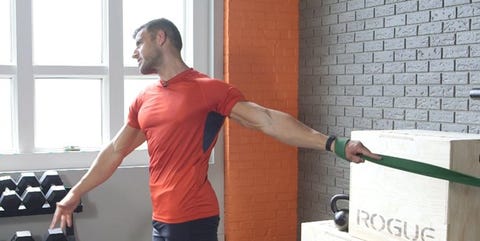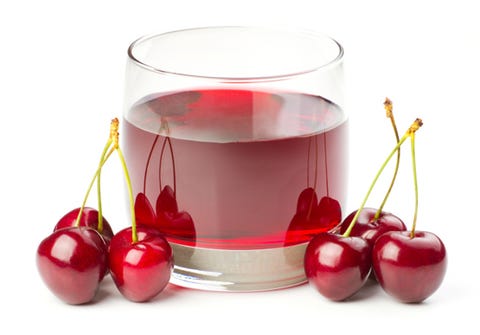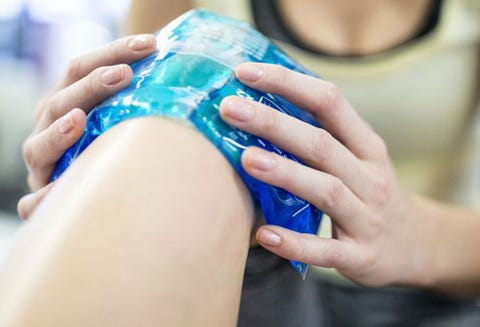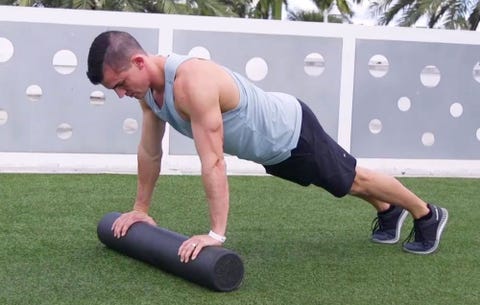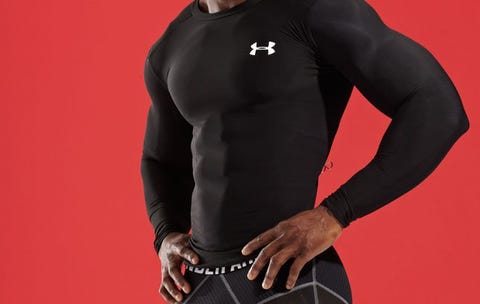
We all secretly love sore muscles. It’s proof you put in serious work at the gym, and your body is feeling it. But some muscle soreness isn’t simply due to lactic acid buildup — it’s a sign you straight-up sent your muscles into shock.
“The significant muscle soreness that typically occurs hours after activity, usually 24 to 48 hours after activity, is referred to as delayed onset muscle soreness. or DOMS,” Christopher Hogrefe, MD, FACEP, orthopedic surgeon at Northwestern Medicine, told MensHealth.com. “This condition has little, if anything, to do with lactic acidosis. Instead, it appears to be the result of small tears in muscle fiber that combine with an inflammatory process to result in pain.”
Ouch.
You’ll notice this type of soreness after more challenging or unfamiliar exercise. “Activities that involve muscle and tendon lengthening while a person simultaneously tries to contract the muscle, Squats and running downhill, are examples of such exercises,” says Hogrefe.
So what are the symptoms of DOMS? “Muscle soreness, lack of strength, decrease in the speed of muscle contractibility, and muscle stiffness are all symptoms of DOMS,” says says Katie Lawton, an exercise physiologist in Rehabilitation and Sports Therapy at the Cleveland Clinic. “DOMS can decrease the speed of muscle contractibility by 5-8% and change joint mobility.”
If your body needs a little more help with recovery, try one of these tips to get rid of sore muscles.
Unsplash
“Numerous sources have identified mushrooms as possessing anti-inflammatory properties that may be effective in reducing some muscle soreness,” says Hogrefe. Mushrooms’ anti-inflammatory compounds called polysaccharides work to reduce the inflammation-causing cytokine compounds.
Nicholas Grieves
Spending some time cooling down makes your muscles recovery-ready. A 2018 study on active recovery found that runners who spent time at a 50% decrease in activity at the end of their workout (instead of resting completely) were able to go three times longer the second time they ran. The researchers believe it had to do with better blood flow, which reduced blood lactate (the metabolic byproduct that makes your muscles sore).
Plus, a 2012 study found that those who did 20-minutes of low- or moderate-intensity cycling immediately following their strength workout reported reduced muscle pain.
Gallery Stock
Tart cherry juice is loaded with antioxidants and anti-inflammatory compounds. A 2010 study found that long distance runners who drank tart cherry juice for 8 days reported decreased muscle pain.
“Much like mushrooms, the anti-inflammatory properties in cherries may be beneficial in decreasing muscle soreness. However, particularly in the case of tart cherry extract, one should be aware of the significant sugar content that could be present,” says Hogrefe.
Zeel
It may seem obvious, but massages really do help get rid of sore muscles. A 2012 study found that a post-exercise massage significantly reduces pain by reducing the release of cytokines, compounds that cause inflammation in the body. At the same time, massage stimulated mitochondria in cells, promoting cell function and repair.
Getty Images
“The idea behind heating pads is that they increase blood flow because it is a vasodilator (opens up your blood vessels), and is thought that it could help flush some of the byproducts or inflammation related to muscle soreness, out of the muscles,” says Lawton.
Adding an ice pack to the mix may be the perfect combination.
“Alternating cold and heat may be most beneficial following exercise-induced muscle soreness,” says Hogrefe.
A 2015 study found that using both heat and ice prevented elastic tissue damage. “Going from icing to heating reduces muscle pain after exercising. Applying ice for twenty minutes followed by heat for twenty minutes may be an effective regimen to help address muscle soreness following activity,” says Hogrefe.
Men's Health
Foam rolling on sore muscles can make grown men cry, but it seriously helps repair your muscles. “It has been suggested that foam rolling may decrease edema (or swelling in the muscles) and enhance tissue healing,” says Hogrefe.
A 2015 study found that 20 minutes of foam rolling on a high-density foam roller immediately following exercise and 24 hours after may reduce muscle tenderness and decrease the impact on one’s dynamic movements.
Getty Images
A 2010 study found that ice baths reduce swelling and tissue breakdown that causes DOMS by constricting blood vessels. Participants sat in the ice bath for 5 to 10 minutes. And in another study from 2014, participants who took ice baths for 10 minutes after exercise reported the lowest levels of pain and muscle soreness when asked to stretch.
“Overall, some have suggested that ice baths can reduce muscle soreness by 20%,” says Hogrefe.
Gallery Stock
It’s not just to show off all the work you’ve put in. A 2014 study found that compression gear reduced muscle soreness and made muscle recovery faster due to constricting your muscles and preventing fluid buildup post-workout while increasing blood flow. This helped remove an enzyme in your muscles called creatine kinas, which can cause ache.
Source: Read Full Article

